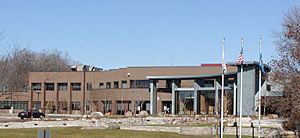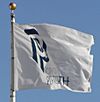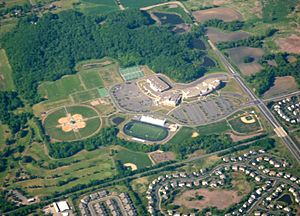Plymouth, Minnesota facts for kids
Quick facts for kids
Plymouth
|
||
|---|---|---|

Plymouth City Hall
|
||
|
||

Location of Plymouth
within Hennepin County, Minnesota |
||
| Country | United States | |
| State | Minnesota | |
| County | Hennepin | |
| Incorporated as a township | 1858 | |
| Incorporated as a village | 1955 | |
| Incorporated as a city | 1974 | |
| Area | ||
| • City | 35.28 sq mi (91.38 km2) | |
| • Land | 32.71 sq mi (84.72 km2) | |
| • Water | 2.57 sq mi (6.66 km2) | |
| Elevation | 971 ft (296 m) | |
| Population
(2010)
|
||
| • City | 70,576 | |
| • Estimate
(2019)
|
79,768 | |
| • Rank | US: 438th MN: 7th |
|
| • Density | 2,438.57/sq mi (941.53/km2) | |
| • Metro | 3,629,190 (US: 16th) | |
| Time zone | UTC-6 (Central (CST)) | |
| • Summer (DST) | UTC-5 (CDT) | |
| ZIP codes |
55441, 55442, 55446, 55447
|
|
| Area code(s) | 763 | |
| FIPS code | 27-51730 | |
| GNIS feature ID | 0649598 | |
Plymouth is a suburban city in the U.S. state of Minnesota 15 miles (24 km) west of downtown Minneapolis in Hennepin County. It is located on the western edge of the Minneapolis suburbs.
According to the 2019 Metropolitan Council estimate, Plymouth's population is 79,768. The population was 70,576 at the 2010 Census. Once named for Medicine Lake, the city's name was chosen by Hennepin County Commissioners during the county's inception.
Contents
History
Plymouth's history can be traced back to the pre-Columbian period around 1400 to 1500 AD. The original inhabitants were the Dakota. Their encampment was at the north end of Medicine Lake. The name Medicine Lake is derived from the Dakota word Mdewakanton, meaning "Lake of the Spirit." The Dakota named the lake after a warrior overturned his canoe and his body was never recovered.
Antoine LeCounte, a guide and explorer, was the first settler to this area. He arrived in 1848, but did not settle until 1852. He carried mail from the Red River country to points south, trading goods to Native Americans for horses on the way. LeCounte built the first cabin at what is now East Medicine Lake Boulevard at 29th Avenue North.
Plymouth's beginning as a town occurred in 1855 on the northwest shores of what is now known as Parkers Lake. A gristmill and other structures were built in the area. In the spring of 1857, when Parkers Lake flooded, the mill was taken down and moved to Freeport. Freeport is now named Wayzata.
As new settlers arrived in the area, they decided to organize. The Hennepin County Board of Commissioners named the new settlement Plymouth. On April 19, 1858, a group of townspeople met at the home of Francis Day to open elections for town offices. On May 11, 1858, the group voted to change the town's name to Medicine Lake. This was used once at the town meeting, but for reasons, which were not recorded, it was never used again.
During the Dakota War of 1862 between white settlers and the Dakota at Fort Ridgely, near New Ulm, the settlers of Plymouth formed a militia. When the Civil War started, Plymouth paid its volunteers $25 to enlist. At about this time, Plymouth's growth began to take on a new look. Schools and churches were built and a post office was located in Plymouth. By 1863, hotels were being built.
More changes occurred after the Civil War. By 1880, Plymouth boasted a population of 1,074, and reaped $667 in annual taxes. Farming became the trade of most settlers. Roads were built across Plymouth, making access to other towns possible. Medicine Lake had become a major tourist attraction and resorts were built around its shores.
As the character of the community evolved, so did local government. Plymouth incorporated as a village on May 18, 1955. The city adopted the Council–Manager form of government on August 1, 1968. Plymouth became a statutory city on February 7, 1974. It remained a statutory city until voters opted to make it a home rule charter city by adopting a City Charter on November 3, 1992. The City Charter went into effect on January 1, 1993. The Charter continued the Council–Manager form of government, and increased the size of the City Council. Before the adoption of the Charter, the City Council was made up of five members elected at-large. The Charter increased the Council to seven members elected from four wards.
Plymouth was named by Money Magazine the number one city in which to live in the United States in 2008. The magazine gave top honors to Plymouth because of its inclusion of residential areas, industry, parks, schools, and other aspects which make Plymouth a self-contained and essentially autonomous city.
Geography
According to the United States Census Bureau, the city has a total area of 35.33 square miles (91.50 km2), of which 32.68 square miles (84.64 km2) is land and 2.65 square miles (6.86 km2) is water.
Interstate 494, U.S. Highway 169, and Minnesota State Highway 55 are three of the main routes in the city. Plymouth has 863 cul-de-sacs and 300 miles of city streets, which are maintained by the city’s public works crews.
Climate
Plymouth has a humid continental climate, typical of the Midwestern United States, with very cold winters, and hot, often humid summers. Summer daytime temperatures average 83 °F (28 °C), with a low of around 60 °F (15 °C), while winter temperatures average only 23 °F (-5 °C) and a low of 3 °F (-16 °C). The highest recorded temperature in Plymouth was 99 °F (37 °C) in 1964, and the lowest was -39 °F (-39.4 °C) in 1977. Rainfall is spread throughout the year, with the most rain being received in the summer months, with June being the wettest, with 120.3 mm of rain.
| Climate data for Plymouth, Minnesota | |||||||||||||
|---|---|---|---|---|---|---|---|---|---|---|---|---|---|
| Month | Jan | Feb | Mar | Apr | May | Jun | Jul | Aug | Sep | Oct | Nov | Dec | Year |
| Record high °F (°C) | 55 (13) |
59 (15) |
83 (28) |
92 (33) |
95 (35) |
102 (39) |
99 (37) |
96 (36) |
96 (36) |
87 (31) |
73 (23) |
61 (16) |
102 (39) |
| Average high °F (°C) | 23 (−5) |
29 (−2) |
41 (5) |
57 (14) |
71 (22) |
78 (26) |
83 (28) |
80 (27) |
72 (22) |
59 (15) |
41 (5) |
27 (−3) |
55 (13) |
| Average low °F (°C) | 3 (−16) |
10 (−12) |
27 (−3) |
34 (1) |
47 (8) |
56 (13) |
60 (16) |
58 (14) |
49 (9) |
37 (3) |
24 (−4) |
10 (−12) |
35 (1) |
| Record low °F (°C) | −39 (−39) |
−31 (−35) |
−27 (−33) |
−5 (−21) |
18 (−8) |
33 (1) |
42 (6) |
36 (2) |
22 (−6) |
9 (−13) |
−19 (−28) |
−33 (−36) |
−39 (−39) |
| Average precipitation inches (mm) | 0.90 (22.8) |
0.66 (16.7) |
1.68 (42.6) |
2.41 (61.2) |
3.54 (89.9) |
4.74 (120.3) |
4.16 (105.6) |
4.02 (102.1) |
3.3 (85) |
2.50 (63.5) |
1.64 (41.6) |
0.90 (22.8) |
30.45 (774.1) |
| Source: http://www.weather.com/weather/wxclimatology/monthly/graph/55447?from=tenDay_bottomnav_undeclared | |||||||||||||
Demographics
| Historical population | |||
|---|---|---|---|
| Census | Pop. | %± | |
| 1860 | 393 | — | |
| 1870 | 872 | 121.9% | |
| 1880 | 1,072 | 22.9% | |
| 1890 | 1,053 | −1.8% | |
| 1900 | 1,164 | 10.5% | |
| 1910 | 1,221 | 4.9% | |
| 1920 | 1,275 | 4.4% | |
| 1930 | 1,683 | 32.0% | |
| 1940 | 2,989 | 77.6% | |
| 1950 | 5,813 | 94.5% | |
| 1960 | 9,576 | 64.7% | |
| 1970 | 18,077 | 88.8% | |
| 1980 | 31,615 | 74.9% | |
| 1990 | 50,889 | 61.0% | |
| 2000 | 65,894 | 29.5% | |
| 2010 | 70,576 | 7.1% | |
| 2020 | 81,026 | 14.8% | |
| U.S. Decennial Census 2018 Estimate |
|||
According to a 2007 estimate, the median income for a household in the city was $80,949, and the median income for a family was $101,630.
2010 census
As of the census of 2010, there were 70,576 people, 28,663 households, and 19,230 families living in the city. The population density was 2,159.6 inhabitants per square mile (833.8/km2). There were 29,982 housing units at an average density of 917.4 per square mile (354.2/km2). The city's racial makeup was 84.2% White, 5.2% African American, 0.3% Native American, 6.9% Asian, 1.0% from other races, and 2.3% from two or more races. Hispanic or Latino of any race were 3.0% of the population.
There were 28,663 households, of which 32.4% had children under the age of 18 living with them, 55.6% were married couples living together, 8.5% had a female householder with no husband present, 3.0% had a male householder with no wife present, and 32.9% were non-families. 26.4% of all households were made up of individuals, and 8% had someone living alone who was 65 years of age or older. The average household size was 2.42 and the average family size was 2.96.
The median age in the city was 39.5 years. 23.9% of residents were under the age of 18; 6.9% were between the ages of 18 and 24; 27.1% were from 25 to 44; 30.1% were from 45 to 64; and 12.1% were 65 years of age or older. The gender makeup of the city was 48.4% male and 51.6% female.
Economy
OneBeacon, Select Comfort, Christopher & Banks and Tonka Water are headquartered in Plymouth.
Principal employers
According to Plymouth's 2020 Comprehensive Annual Financial Report, the principal employers in the city are:
| # | Employer | # of Employees |
|---|---|---|
| 1 | Prudential Financial | 3,000 |
| 2 | I.S.D. No. 284 (Wayzata) | 2,025 |
| 3 | Zayo Group | 2,000 |
| 4 | Medtronic | 1,001 |
| 5 | Aimia | 1,000 |
| 5 | TCF Bank | 1,000 |
| 7 | US Foods | 700 |
| 8 | Meritain Health | 600 |
| 9 | Smiths Medical ASD, Inc | 576 |
| 10 | Minnesota Rubber & Plastics | 500 |
| 10 | Sterilmed, Inc | 500 |
Education
Public schools
Five school districts serve Plymouth, Wayzata Public Schools (ISD 284), Robbinsdale Area Schools (ISD 281), Osseo School District (279), West Metro Education Program (ISD 6069) and Hopkins School District (ISD 270). The majority of the city, particularly the western, northwestern, and southern areas, is served by Wayzata Public Schools. Robbinsdale Area Schools serves the east-central area of Plymouth. The Osseo District includes the northeast area and Hopkins includes the southeast corner of Plymouth. Some students attend public schools in other school districts chosen by their families under Minnesota's open enrollment statute.
- Birchview Elementary School
- Fair School Pilgrim Lane
- Gleason Lake Elementary School
- Greenwood Elementary School
- Kimberly Lane Elementary School
- Meadow Ridge Elementary School
- North Woods Elementary School
- Oakwood Elementary School
- Plymouth Creek Elementary School
- Plymouth Middle School
- Robbinsdale Armstrong High School
- Sunset Hill Elementary School
- Wayzata East Middle School
- Wayzata Central Middle School
- Wayzata West Middle School
- Wayzata High School
- Zachary Lane Elementary School
Wayzata High School is operated by the Wayzata School District, has approximately 3500 students in grades 9 to 12 (2011), making it the largest secondary school by enrollment in Minnesota. Projected enrollment for the 2012-2013 School Year is 3617. It is also the largest Minnesota secondary school by structural size, with an interior of 487,000 square feet (45,200 m2). The school is part of the Lake Conference. In 2008, Newsweek ranked the school #940 "List of the 1300 Top High Schools in America."
Robbinsdale School District
- Robbinsdale Plymouth Middle School
- Fair School Pilgrim Lake
- Zachary Lane Elementary School
West Metro Education Program (WMEP) District 6069
- The InterDistrict Downtown School (IDDS)
- FAIR (Fine Arts Interdisciplinary Resource) School
Private schools and colleges
- Association Free Lutheran Bible School and Seminary
- Fourth Baptist Christian School
- Central Baptist Theological Seminary
- Providence Academy
- West Lutheran High School
Notable people
- Marion Barber III – former NFL running back
- Rudy Boschwitz – US Senator who while serving in office also lived in Plymouth.
- Ariya Daivari – Professional wrestler signed to WWE
- Jonas H. Howe – abolitionist, artist, and state legislator
- Jeff Johnson – Hennepin County Commissioner
- Evan Kaufmann (born 1984) – professional ice hockey player in Germany
- Amy Klobuchar – US Senator and 2020 Democratic presidential candidate
- James Laurinaitis – NFL linebacker
- Mark Parrish – former NHL All Star
- Andrew Tang - chess grandmaster
- A.J. Tarpley – NFL linebacker with the Buffalo Bills
- Blake Wheeler – NHL player
- Dani Cameranesi - Former Olympic Gold Medalist
- Adrianne Lenker - Lead vocalist and guitarist of indie rock band Big Thief
See also
 In Spanish: Plymouth (Minnesota) para niños
In Spanish: Plymouth (Minnesota) para niños



